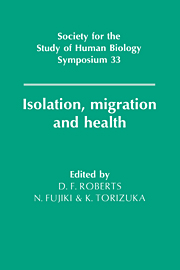Book contents
- Frontmatter
- Contents
- List of contributors
- Preface
- 1 The legacy of the IBP: Presidential Address
- 2 The distinction between primary and secondary isolates
- 3 Time trends in the break-up of isolates
- 4 Factors influencing the frequency of consanguineous marriages in Japan
- 5 Break-up of isolates
- 6 Isolates in India: their origin and characterisation
- 7 Consanguineous marriages and their genetical consequences in some Indian populations
- 8 Biomedical and immunogenetic variation in isolated populations in India
- 9 Genetic distance analyses in Israeli groups using classical markers and DNA polymorphisms in the β globin gene
- 10 Non-random distribution of Gm haplotypes in northern Siberia
- 11 Allele frequency estimation
- 12 Genetic affinities of human populations
- 13 Inherited neurological diseases in island isolates in southern Japan
- 14 Serological and virological evidence for human T-lymphotropic virus type I infection among the isolated Hagahai of Papua New Guinea
- 15 Analysis of genes associated with hypercholesterolaemia in the Japanese population
- 16 Migrant studies and their problems
- 17 Tokelau: migration and health in a small Polynesian society - a longitudinal study
- 18 Micromigrations of isolated Tuareg tribes of the Sahara Desert
- 19 Population structure in the eastern Adriatic: the influence of historical processes, migration patterns, isolation and ecological pressures, and their interaction
- 20 Diabetes and diabetic macroangiopathy in Japanese-Americans
- 21 Diabetes and westernisation in Japanese migrants
- 22 Environmental factors affecting ischemic heart disease
- Epilogue
- Index
13 - Inherited neurological diseases in island isolates in southern Japan
Published online by Cambridge University Press: 05 March 2012
- Frontmatter
- Contents
- List of contributors
- Preface
- 1 The legacy of the IBP: Presidential Address
- 2 The distinction between primary and secondary isolates
- 3 Time trends in the break-up of isolates
- 4 Factors influencing the frequency of consanguineous marriages in Japan
- 5 Break-up of isolates
- 6 Isolates in India: their origin and characterisation
- 7 Consanguineous marriages and their genetical consequences in some Indian populations
- 8 Biomedical and immunogenetic variation in isolated populations in India
- 9 Genetic distance analyses in Israeli groups using classical markers and DNA polymorphisms in the β globin gene
- 10 Non-random distribution of Gm haplotypes in northern Siberia
- 11 Allele frequency estimation
- 12 Genetic affinities of human populations
- 13 Inherited neurological diseases in island isolates in southern Japan
- 14 Serological and virological evidence for human T-lymphotropic virus type I infection among the isolated Hagahai of Papua New Guinea
- 15 Analysis of genes associated with hypercholesterolaemia in the Japanese population
- 16 Migrant studies and their problems
- 17 Tokelau: migration and health in a small Polynesian society - a longitudinal study
- 18 Micromigrations of isolated Tuareg tribes of the Sahara Desert
- 19 Population structure in the eastern Adriatic: the influence of historical processes, migration patterns, isolation and ecological pressures, and their interaction
- 20 Diabetes and diabetic macroangiopathy in Japanese-Americans
- 21 Diabetes and westernisation in Japanese migrants
- 22 Environmental factors affecting ischemic heart disease
- Epilogue
- Index
Summary
Introduction
Not long ago, in many areas in rural Japan there lived almost closed endogamous populations engaged in primary industries. These were local isolates, which barely exist as such today. Yet in particular areas, there are still sometimes unique inherited diseases, and the frequency even of less unusual diseases is sometimes grossly elevated, deriving from the disease pattern of the past when these areas were the home of small or isolated populations. One such area is the Amami islands, inhabited by small and isolated populations characterised by unusual patterns of inherited neurological diseases, especially Ryukyu spinal progressive muscular atrophy which is known only in this area among the descendants of the ancient local rulers.
The Amami islands and their people
An arc of islands, known as the south-western islands, links Kyushu, Japan and the island of Formosa (Taiwan). Administratively the northern half of these islands, including the Amami group, belongs to Kagoshima Prefecture, while the others comprise Okinawa Prefecture, formerly known as the Ryukyus (Figure 13.1).
The neolithic Jomon hunting-gathering culture covered almost the whole of Japan, including most of these islands but excluding northern Hokkaido. The Jomon people depended on the products of the deciduous forests for their staple foods. Following the immigration of newcomers from south-east Asia bringing rice farming, there arose the Yayoi Bronze Age rice-farming culture, and from mixture between the immigrants and the Jomon people sprang the present day Japanese. But people in the south-western islands as well as in northern Japan remained relatively unmixed and retained their hunting-gathering economy because these areas were not suitable for the crude methods of rice farming then available.
- Type
- Chapter
- Information
- Isolation, Migration and Health , pp. 130 - 142Publisher: Cambridge University PressPrint publication year: 1992



